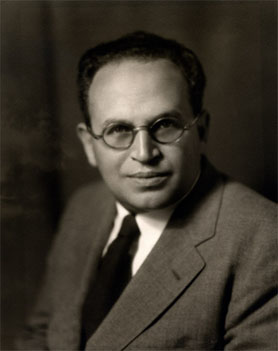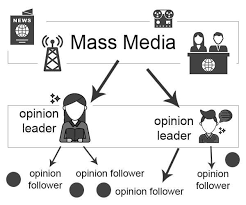Today we’re talking about two-level communication theory.
Two-level communication, which refers to a way of spreading information from the media to opinion leaders and then to the audience, is a theory that was put forward by the famous American sociologist Lazarsfeld in 1940 in his book The People’s Choice. In his study of the American presidential election, Lazarsfeld found that the media could seldom have a direct impact on voters’ intention to vote, and that face-to-face exchange of information between people was more likely to change people’s perceptions and attitudes. This change is generally carried out through the relay of opinion leaders, who are more exposed to the media than the general public, and who are seen by the wider audience as the main channel of information. The message is transmitted from the media to the opinion leaders, and after selective reception, memorization and transmission by the opinion leaders, it reaches the audience and has an impact on them, forming a process of information dissemination. This communication process involves both mass communication and interpersonal communication, with the former, as the first stage, being mainly the process of information conveyance and the latter, as the second stage, being mainly the diffusion of interpersonal influence. This is the well-known two-stage communication hypothesis.

Paul Felix Lazarsfeld (February 13, 1901 – August 30, 1976) was an Austrian-American sociologist. The founder of Columbia University’s Bureau of Applied Social Research, he exerted influence over the techniques and the organization of social research. “It is not so much that he was an American sociologist,” one colleague said of him after his death, “as it was that he determined what American sociology would be.” Lazarsfeld said that his goal was “to produce Paul Lazarsfelds”.  He was a founding figure in 20th-century empirical sociology. [Wikipedia]

BUT…
Two-level communication has led to the recognition of the different roles of mass media channels and interpersonal communication channels in the process of people’s information acquisition and attitudinal change, with mass communication having a significant effect in reinforcing the audience’s pre-existing position, and interpersonal communication having a much stronger impact in changing the audience’s attitudes, for example. However, the theory of two-level communication also has obvious defects:
Firstly, it over-exaggerates the role of opinion leaders in two-level communication. The two-level communication theory believes that opinion leaders are the relay station in information dissemination, and most of the information is delivered to the audience through the diffusion and innovation of opinion leaders, but in fact, most news reports are directly known to the audience through the mass media; opinion leaders do not have a bullet-shooting effect on the audience, and they share information rather than exchanging opinions among themselves.
Secondly, there is an absolutisation of opinion leaders’ sources of information. The two-level communication theory implicitly assumes that the mass media is the only information channel for opinion leaders, but in reality, opinion leaders are not fixed, and an opinion leader in one group may become a follower in another group and be influenced by other opinion leaders, so the sources of information influencing opinion leaders may be varied, which is not addressed by the two-level communication.
Thirdly, it simplifies the process of mass communication, whereas the actual process of communication may have more levels and be more complex.
‘Two-level communication’ in networks…
The phenomenon of “two-tier communication” is still prevalent in the online environment, but with a new twist. Due to the convenience of using the Internet and the diversification of information sources, most of the time information reaches users directly from the media, and the main responsibility of opinion leaders has changed from disseminating information to expressing opinions and conveying views.
“Two-tier communication” is widely used on the Internet, especially in the field of online marketing. In online marketing, online opinion leaders are the core and key: they make use of their influence and attention to persuade their fans through personal experience and endorsement advertisements and shift the public’s attention to their endorsed products in order to promote sales. Because the two-level communication model lacks feedback and interaction mechanisms, it is not enough to use the two-level communication model in network marketing, but also to consider the reaction of consumers.

Reference list
Media Studies. (2020). Two Step Flow Theory of Communication | Definition and Analysis. [online] Available at: https://media-studies.com/two-step-flow/.
Pinterest. (n.d.). taylor swift diet coke | Taylor swift diet coke, Taylor swift, Advertising techniques. [online] Available at: https://www.pinterest.com/pin/789959590881473059/ [Accessed 23 Oct. 2023].
Wikipedia Contributors (2019). Paul Lazarsfeld. [online] Wikipedia. Available at: https://en.wikipedia.org/wiki/Paul_Lazarsfeld.


I agree with you, and by the way I would like to add that opinion leaders (celebrity endorsements) can sometimes cause problems for consumers. For the products endorsed by the stars and the products trusted by consumers are sometimes not so “credible”. Juicero, the maker of juicero, claims its juice is healthier and has landed many celebrity endorsements (Oprah, Kobe Bryant, etc.). But hou’s downfall came after consumers discovered the scam: a custom-made fruit and vegetable package that could be used to store juice by hand rather than by machine. Therefore, we can find that sometimes the information spread by opinion leaders is not necessarily correct. I also have some examples on my blog, if you are interested you can check them out.
You have well explained Two Step Flow, which Lazarsfield et al. proposed in 1948 based on their research on election behavior, stating that the impact of mass communication on people is not direct, but rather a secondary communication process. I also strongly agree with the example you used, which is the well-known Taylor Swift among contemporary youth. It not only enriches your content but also makes your overall structure clearer. Overall, I really like your article.